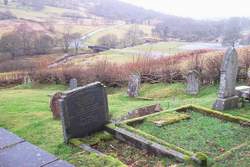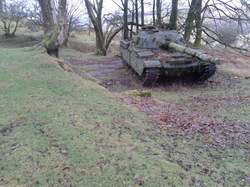Abandoned Communities ..... Mynydd Epynt
In the event the deputation was received by Lord Cobham, Assistant Secretary of State for War, near the end of March, in a meeting that lasted about an hour. The deputation seems to have wanted to stress that it supported the general war effort at a time of national crisis, but it argued that the Government's proposals would lead to a major loss of agricultural land and it would be wrong to uproot and disperse a traditional Welsh community. It urged the War Office to go on seeking an alternative site.
Members of the deputation seem to have come away believing that their views and arguments would be given further consideration. However, it is clear that the Government had gone too far down the road towards completing the requisitions, and the plan duly went ahead. The Government had in fact already granted an extension of the deadline, but everyone was required to leave by 1 June. Livestock were to be removed by 30 June as it was intended that live firing on the artillery range would begin on 1 July.
In June 1940 Iorwerth Peate made several visits to Mynydd Epynt and Mynydd Bwlch-y-groes. On the staff of the National Museum of Wales, he had been asked to carry out a final survey and take photographs. On his last visit near the end of June Peate found "locked doors, unadorned windows with the panes staring vacantly at me, a cat which had been left behind retreating nervously through a hole in the cowshed door, an occasional cow or heifer, which would be collected on a last visit, running confidently towards me on seeing a living being in that deadly silence which they could not understand".
A few people were still in the process of moving. Iorwerth Peate passed the family from Hirllwyn "with their load of furniture on a cart coming through the mountain gate". He met a lady of eighty two who was expecting to leave later that day. "She had dragged an old chair to the furthest end of the yard and was sitting there motionless, gazing towards the mountain with tears streaming down her cheeks". She told Peate to get back to Cardiff as soon as he could, adding "it is the end of the world here".
Some of the people of Epynt found accommodation nearby. Others had to move further away. A large number of them found only temporary homes at first and had to move again at least once before they began to feel settled. The teacher at Cilieni School, Mrs Olwen Davies, obtained another post at Llanddulas, now known as Tirabad. Rev. William Jones, who had been the "pregethwr" at Babell chapel since 1909, took retirement.
Pregethwr means preacher or minister.
Landowners received payments amounting to the value of their property. They also received compensation for such items as farmyard manure, temporary pasture, and fencing, and they could be paid the equivalent of two years’ rent in recognition of their “claim for disturbance”. If, however, you were a shepherd with no property of your own you were likely to lose your livelihood and receive no financial compensation.
Some of the residents attempted to maintain contact with Epynt, perhaps hoping that the war might end soon and it might be possible to return. Thomas Morgan from Glandwr used to slip back to his farm and light the fire to keep the house aired. One day he arrived to find his home in ruins. An army captain told him it had been blown up and he was not expected to come back again.
Rhys Price was more fortunate. He would go back to tend the cemetery at the chapel, lay flowers on the graves, and trim the hedges. Travelling by bicycle he would carry a scythe and enough food to last the day. At a later date the army provided transport for him, and he continued to perform his duties until 1985, when he was 82.
Today the graveyard remains, but the chapel has fallen into ruin and has been tidied up. Only the foundations are still there. On the site of the chapel is a plaque bearing a magnificently appropriate quotation, Isaiah chapter 2 verse 4.
I'll leave you to look it up.
Members of the deputation seem to have come away believing that their views and arguments would be given further consideration. However, it is clear that the Government had gone too far down the road towards completing the requisitions, and the plan duly went ahead. The Government had in fact already granted an extension of the deadline, but everyone was required to leave by 1 June. Livestock were to be removed by 30 June as it was intended that live firing on the artillery range would begin on 1 July.
In June 1940 Iorwerth Peate made several visits to Mynydd Epynt and Mynydd Bwlch-
A few people were still in the process of moving. Iorwerth Peate passed the family from Hirllwyn "with their load of furniture on a cart coming through the mountain gate". He met a lady of eighty two who was expecting to leave later that day. "She had dragged an old chair to the furthest end of the yard and was sitting there motionless, gazing towards the mountain with tears streaming down her cheeks". She told Peate to get back to Cardiff as soon as he could, adding "it is the end of the world here".
Some of the people of Epynt found accommodation nearby. Others had to move further away. A large number of them found only temporary homes at first and had to move again at least once before they began to feel settled. The teacher at Cilieni School, Mrs Olwen Davies, obtained another post at Llanddulas, now known as Tirabad. Rev. William Jones, who had been the "pregethwr" at Babell chapel since 1909, took retirement.
Landowners received payments amounting to the value of their property. They also received compensation for such items as farmyard manure, temporary pasture, and fencing, and they could be paid the equivalent of two years’ rent in recognition of their “claim for disturbance”. If, however, you were a shepherd with no property of your own you were likely to lose your livelihood and receive no financial compensation.
Some of the residents attempted to maintain contact with Epynt, perhaps hoping that the war might end soon and it might be possible to return. Thomas Morgan from Glandwr used to slip back to his farm and light the fire to keep the house aired. One day he arrived to find his home in ruins. An army captain told him it had been blown up and he was not expected to come back again.
Rhys Price was more fortunate. He would go back to tend the cemetery at the chapel, lay flowers on the graves, and trim the hedges. Travelling by bicycle he would carry a scythe and enough food to last the day. At a later date the army provided transport for him, and he continued to perform his duties until 1985, when he was 82.
Today the graveyard remains, but the chapel has fallen into ruin and has been tidied up. Only the foundations are still there. On the site of the chapel is a plaque bearing a magnificently appropriate quotation, Isaiah chapter 2 verse 4.
I'll leave you to look it up.
Four
The graveyard at Babell chapel
The remains of Caerllwyn farmhouse, where Griffith and Megan Price and their family lived until 1940.
This photograph was taken by Philip Evans.

